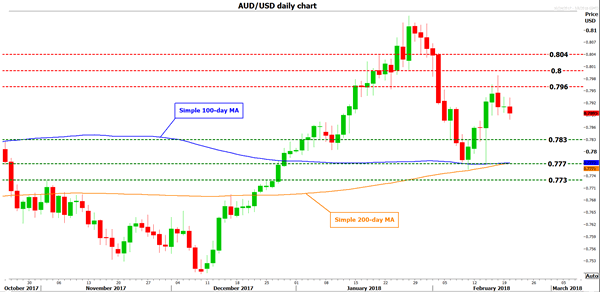Subdued wage growth has been a major source of concern for the Reserve Bank of Australia (RBA) for years now. While the Bank expects wages to pick up, it does not expect that to happen quickly and has thus shown little urgency to raise interest rates. Against that backdrop, traders will keep a close eye on the upcoming wage prints, as they could determine whether the RBA will change its neutral tune anytime soon, or whether it will remain sidelined for longer.
Australia’s Wage Price Index for the fourth quarter will be released on Wednesday at 0030 GMT, and expectations are for wage growth to have held steady at 2.0% in yearly terms, and at 0.5% in quarterly terms. Looking at the forecasts alone, one might be tricked into thinking that unchanged readings might mean little for RBA policymakers and by extent, the Aussie.
In fact, though, the RBA takes every opportunity to remind investors that the combination of subdued wage growth and high household debt levels in Australia is an extremely worrisome cocktail, as it could limit consumption and thus economic growth in the future. Households that are already heavily indebted are unlikely to raise their spending in an environment where their incomes are growing at a very slow pace. Thus, the Bank is very hesitant about raising interest rates and making the debt burden of Australian households even heavier, at least not until wages have accelerated substantially.
Which puts all the more emphasis on wage growth. If the actual print meets the forecast and remains unchanged at 2.0%, that could be viewed as a discouraging development for the Bank, as it would indicate that the rapid tightening in the labor market over recent months has yet to translate into higher wages. Such an outcome may weigh on the Aussie, but perhaps only modestly as it is already largely anticipated by markets. Aussie/dollar could drift lower and aim for a test of the 0.7830 support zone, marked by the lows of February 6.
Now, should wage growth surprisingly slow, say to 1.9% or lower, that would probably curb bets regarding whether the RBA will raise rates this year. The Aussie is likely to fall much more aggressively in this scenario. A clear break below 0.7830 in aussie/dollar could open the way for a test of the pair’s latest lows near 0.7770, which also coincides with both the 100-day and 200-day moving averages. If sellers manage to overcome that zone, then the 0.7730 area may come into play, identified by the lows of October 6.
On the contrary, in case wages surprise to the upside, for instance if the yearly rate clocks in at 2.1% or above, that would most probably raise speculation that the RBA could proceed with a rate hike sooner rather than later. Such an outcome is likely to boost the Australian currency. Aussie/dollar is possible to climb and initially test the 0.7960 area. A decisive break above that hurdle could pave the way for the psychological territory of 0.8000. In case of even further advances, resistance may be met around the 0.8040 barrier, identified by the inside swings low on January 30 and 31.
As for which outcome is more likely, wage gauges did not paint a clear picture during the quarter. The NAB business survey for December found that labor costs had risen at the same pace as in the previous quarter, which is in line with the market forecasts. However, the NAB’s quarterly survey for Q4 made it clear that the availability of suitable labour is increasingly becoming a major concern for firms, which in isolation, suggests that the risks surrounding the wage growth forecast may be tilted somewhat to the upside.














